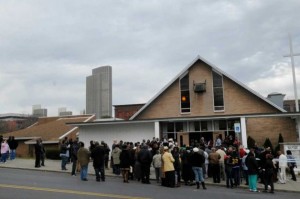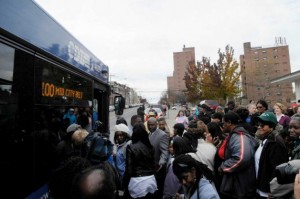In the summer of 2009, AVillage, Inc., a grassroots organization committed to improving the quality of life in Albany’s South End neighborhood, engaged my services. The advocacy group sought direct CDTA bus service from this low income, inner city neighborhood to the corridor housing three of the City’s major medical centers (i.e. Albany Stratton VA Medical Center, Albany Medical Center and St. Peter’s Hospital). Joining this effort were its community partners – Trinity Alliance of the Capital Region,Grand Street Community Arts Center, and Westminster Presbyterian Church.
 As an economically disadvantaged neighborhood, a high percentage of South End residents do not have cars, making them dependent on transit to meet their transportation needs. While transit service was available in the neighborhood, it was impractical to reach the hospitals. It required residents to take a bus or walk downtown, significantly lengthening their commute, or walk up steep Morton Avenue to catch cross-town service, a difficult climb, particularly for the community’s disabled and large senior population. Too often, residents would miss appointments or pay expensive cab fares to make these trips. The requested service would give South End residents direct access to job opportunities, medical appointments, shopping and other businesses as well as transfers to buses serving the greater Capital District.
As an economically disadvantaged neighborhood, a high percentage of South End residents do not have cars, making them dependent on transit to meet their transportation needs. While transit service was available in the neighborhood, it was impractical to reach the hospitals. It required residents to take a bus or walk downtown, significantly lengthening their commute, or walk up steep Morton Avenue to catch cross-town service, a difficult climb, particularly for the community’s disabled and large senior population. Too often, residents would miss appointments or pay expensive cab fares to make these trips. The requested service would give South End residents direct access to job opportunities, medical appointments, shopping and other businesses as well as transfers to buses serving the greater Capital District.
Our first step in addressing the transit issue was to speak with transportation staff. They were unconvinced of the level of demand for service and doubtful that even if the demand were there, we would see any new service given CDTA’s shrinking funding. In response we decided to approach the CDTA Board. Looking at the composition of its members, we noted that: 1) none of the nine members came from one of the four cities within the Capital District, 2) none were actual transit riders though one was a transit advocate; and 3) there was an Albany County seat vacancy.
Soon thereafter we approached the CDTA Board with a petition signed by over 1,300 people, the majority of whom were from the South End or the other inner city neighborhoods which would benefit the most from this service. We also presented the results of a transportation questionnaire showing a large pent up demand for the service especially for medical and work trips, and its anticipated frequent use (2-5X/week). Finally, we gave them support letters from fourteen prominent individuals and organizations, among them Albany Medical Center, City of Albany Common Council members, the Albany Housing Authority, local housing and human service groups, church leaders, and neighborhood associations.

Ultimately the service was created through a new transit loop serving not only the South End but Arbor Hill and West Hill as well, giving all three inner city neighborhoods a direct connection to the medical centers. (CDTA has since reported that ridership on this new route is double what was expected to the point that overcrowding is now an issue.)
On November 13, 2011 I joined about a hundred South End residents and community leaders gathered at the Union Missionary Baptist Church on Morton Avenue. We chanted “this is how democracy works” as the new CDTA bus #100 pulled up for the first time. A major victory had been won for both the neighborhood and for CDTA.
By Monique Wahba, Principal and Owner of MW Planning (www.mwplanning.org)
CDTA and local organizations have proven that system operators throughout New York State can make positive steps forward by engaging communities to best utilize existing resources. But we here at the New York State Transportation Equity Alliance (NYSTEA) and our 80+ coalition members see that there are fundamental statewide issues that need to be addressed. Join NYSTEA as we make the case for voting rider representation on transit authority boards. Riders can and should have the right to be recognized as a transit stakeholder.


 0 Comments
0 Comments  Print
Print
 Email
Email